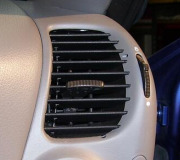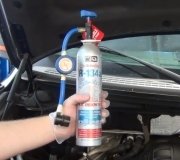You are looking in the wrong direction. First understand that the goal of all automotive air conditioning systems is to lower the temperature of the air by only twenty degrees. That alone is a real big task considering the huge volume of air passing into the car. The comfort comes from removing the high humidity from that air.
Your observation that some cooling is taking place is proof the system is working, so there is no point in searching for fuses and relays. A better observation would be to watch the AC compressor to see if it is cycling on and off while the engine is running. If it is, and especially if it is doing that quite rapidly, the common suspect is the system is low on refrigerant. That causes the cooling to take place too soon in the system, meaning the cooling is occurring in the hose under the hood, not in the dash by the incoming air. The proper fix for that is to have the system drained, then the exact measured amount of refrigerant is pumped in. The low-cost approach is to add one can of refrigerant with a do-it-yourselfer kit. If you attempt that, be aware refrigerant is extremely dangerous to work with. It can cause frost bite and blindness. Professionals wear gloves, safety glasses, and a face shield.
Also, be aware that when adding some results in the system working better, adding more refrigerant is worse than having not enough. All A/C systems work on the principle of a liquid becoming real cold when it turns into a vapor. That is designed to occur in the middle of the "evaporator" in the middle of the dash. If the system has too much refrigerant, the liquid will not turn to a vapor until it gets back out under the hood. Besides not cooling the incoming air, that liquid could slosh into the compressor and destroy it. Compressors can only pump a vapor, never a liquid.
Friday, November 27th, 2020 AT 8:24 AM
(Merged)
















